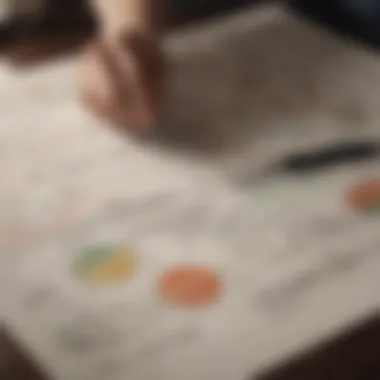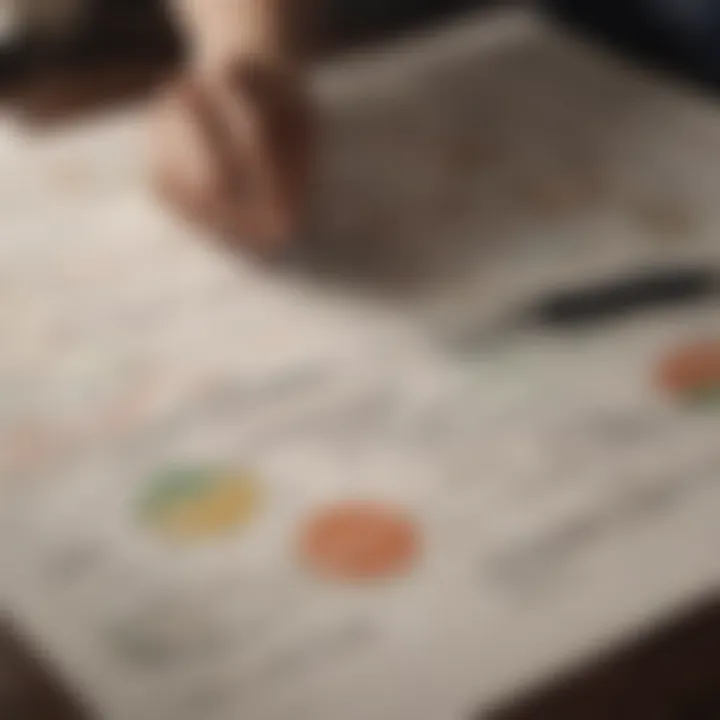Understanding Your Debt: A Complete Guide to Assessment


Overview of the Topic
When we dive into finances, understanding your debt status is not just a nice-to-have; it is absolutely essential. Many people overlook how debts could weigh heavily on their financial decisions. Noting the variety of debts—be it personal loans, credit cards, or student loans—can be as eye-opening as it is alarming. Ignoring them is akin to sailing a ship without checking for leaks.
Assessing your debt provides clarity. It sheds light on your current financial landscape, letting you take control of your personal economy. Knowledge here isn't merely power; it’s a foundational step toward financial stability. Understanding your debts can also open doors to better budgeting, so you can chart a course to nurture savings and investment opportunities.
Definition and Importance of the Topic
Debt is essentially money borrowed and expected to be paid back with interest. The importance of evaluating one's debt status goes beyond mere numbers. It entails recognizing the obligations that have the potential to influence your spending habits and saving capabilities significantly. Oftentimes, people fall into a cycle of rationale where they rationalize their debt without really comprehending its implications.
Key Benefits and Implications
Here’s a breakdown of the benefits derived from understanding your debt:
- Improved financial literacy: Knowledge is the first step toward mastery. When you know your debts, you understand your financial health better.
- Enhanced credit score: Knowing and managing your debts responsibly can positively affect your credit report.
- Greater peace of mind: Eliminating the unknown always reduces stress. When you acknowledge your debts, you prepare to tackle them effectively.
- Strategic planning: Once you're aware of your debts, planning becomes more straightforward. You can set priorities for payment schedules and financial goals.
Exploring Strategies and Tips
Understanding your debt is one thing; implementing strategies to manage it is another ball game. Here are some practical tips for getting a handle on your situation:
- Create a debt inventory: List all your debts and include balances, interest rates, and due dates. This detailed view is invaluable.
- Prioritize your debts: Use methods such as the snowball effect or avalanche method to structure payments. Snowball focuses on small debts first, while avalanche targets those high-interest ones.
- Reflect on spending habits: Examine where your money goes each month. Are there unnecessary expenses pooling your funds unnecessarily?
- Seek professional help if needed: Sometimes, a financial advisor can offer insights tailored to your situation. Don't shy away from asking for guidance.
Strategies for Effective Management
When managing debt, the tried-and-true strategies can help.
- Set specific goals: Whether it is reducing debt by a certain percentage in a year or making a substantial payment by a particular date, goals can give you a sense of direction.
- Automate payments: Setting up automatic payments for debts might just save you from missing due dates, thereby preventing extra fees.
- Balance transfer credit cards: If you have high-interest credit cards, consider looking into balance transfer options to lower your interest rates temporarily.
Case Studies and Examples
Sometimes, seeing just how others navigated their debt can be illuminating. Consider Jane, who found herself overwhelmed by a combination of student and credit card debt. By taking a good hard look at her financials, she consolidated her debts into one manageable personal loan, significantly lowering her monthly payment and interest rate.
However, not everyone gets it right. Take Mark, who ignored his growing credit card balance. Instead of tackling it straight away, he let interest stack up until the charges were overwhelming. His example serves as a cautionary tale, highlighting that ignorance can lead to financial peril.
Expert Insights and Recommendations
Financial experts consistently provide insights that revolve around the same crucial point: awareness is fundamental. Dr. Alex Martinez, a financial behavior specialist, highlights the importance of not only tracking your debt but also understanding your emotional relationship with spending.
- Practice mindfulness in spending: According to Dr. Martinez, acknowledging emotions tied to spending can save you from painful debt scenarios.
- Regularly reassess your debt plan: What works today may not be effective tomorrow. Continue to adapt and refine your strategies as you learn more.
Understanding Debt
Debt is a critical concept that affects nearly everyone at some point in their financial journey. Understanding debt is fundamental when evaluating your financial condition and making informed choices. It’s not merely about knowing how much you owe, but it’s about grasping the implications, types, and how it intertwines with your overall financial health.
Recognizing the types of debt you may encounter can help clarify your financial landscape. Each type carries its own characteristics, which influences how they can impact your credit score, your mental well-being, and your ability to achieve financial goals. By dissecting these components, individuals can find a clearer path towards managing their obligations and reducing the burden of debt.
Understanding debt also brings clarity in recognizing its distinction from assets. It’s crucial to know where you stand; after all, a good balance between investments and obligations can pave the way for financial stability. At its core, debt can either be a tool to help build wealth or a heavy chain that drags you down. Therefore, understanding debt isn’t merely an academic exercise—it’s a necessary step towards achieving financial freedom.
"A penny saved is a penny earned, but a penny borrowed can cost you far more in the long run."
Defining Debt
Debt, in its essence, is an amount of money that you borrow from a lender with the promise to repay it under specified terms. These terms typically encompass interest rates, repayment periods, and consequences for failing to repay, like penalties or even asset seizure. Essentially, taking on debt means you're making a financial commitment that requires careful consideration. Understanding what constitutes debt is not just important; it’s vital to navigating your financial landscape.
Types of Debt
Secured Debt
Secured debt is backed by collateral—this could be a house, a car, or another form of valuable asset. This type of debt is often viewed as less risky for lenders because they have the right to reclaim the asset if payments are not made. The lower risk often translates to lower interest rates, making secured debt a popular choice for large purchases like mortgages or car loans. However, the unique feature of secured debt is that it carries the risk of losing your asset if you can’t keep up with payments. It’s a double-edged sword; while it provides necessary financing, it can also lead to significant consequences if managed poorly.
Unsecured Debt
In contrast, unsecured debt is not tied to any asset. This includes credit cards, personal loans, and student loans. Because it’s not secured by collateral, lenders face more risk, which often results in higher interest rates compared to secured options. Unsecured debt is a double-edged sword, too; it can serve immediate needs without attaching a physical asset but comes with the potential for escalating interest and fees. For many, this type of debt is easy to obtain, which might lead to taking on more than one can handle.
Revolving Debt
Revolving debt refers to credit that's available to you up to a certain limit, allowing you to borrow and repay continuously. A common example is credit cards. What sets revolving debt apart is its flexibility; you can borrow up to your limit, pay it down, and then borrow again without needing to apply for new credit. However, it can quickly spiral out of control if not managed wisely. Because interest rates can be steep, it’s essential to keep a close eye on spending and payments associated with revolving debt.
Debt vs. Asset Evaluation
When assessing your financial health, differentiating between debt and assets is vital. While debt represents what you owe, assets symbolize what you own. A comprehensive evaluation entails listing down all debts and assets to visualize your net worth accurately. It’s not just about numbers—this process can reveal patterns in spending and saving habits, ultimately guiding you towards critical changes that can positively impact your financial future. Understanding the balance between debt and assets can empower individuals to make more strategic choices in managing their finances.
Signs You Might Have Debt
Determining whether you are encumbered by debt is not always straightforward. The signs can often be subtle, enough to let individuals overlook their growing financial burdens until it’s too late. Recognizing these signs is crucial for maintaining financial health and steering clear of the pitfalls that accompany unchecked debt. By identifying potential indicators of debt, readers can take proactive steps toward regaining control over their financial situation. Below are some critical signs that may suggest an unsustainable debt load.
Missing Payments
One of the clearest signs that one might be in debt is having difficulty keeping up with monthly payments. Missing payment deadlines can trigger a cycle of late fees and increased interest rates. It’s about more than just the money lost; it can snowball into a major stressor, affecting broader aspects of life. If paying the electric bill or rent feels like trying to juggle flaming torches, it might be time to take a step back and assess overall financial standing.


Why Missed Payments Matter:
- They can lead to worsening credit scores.
- Frequent misses can escalate collection threats.
- They often indicate financial mismanagement.
If this missing payment pattern is ongoing, it could signal an underlying issue with cash flow or spending priorities. Monitoring due dates, through calendars or alerts, can serve as a check on financial habits.
Living Paycheck to Paycheck
For many, living paycheck to paycheck isn't just a slogan but a reality. This frantic cycle can keep individuals in a state of financial turmoil, preventing them from saving and planning for the future. When the next paycheck feels like a lifeline rather than a means to progress, it suggests a deeper financial frailty.
Living this way often means:
- You're consistently analyzing costs instead of enjoying life.
- Breathing space for unexpected expenses is nonexistent.
- Any financial emergency throws you into a scramble.
Simply so, it’s essential to keep an eye on these patterns. Developing a sustainable budget can provide clarity and help pave a path toward stability. Budgeting could be as simple as listing out necessary expenses, possible savings, and discretionary spending.
Frequent Borrowing
If borrowing has become a frequent activity, that’s another indicator that debt might be creeping in. It might start innocently enough, with small loans or credit card advances to cover unexpected costs or larger purchases. However, if borrowing has become habitual, it raises flags about spending habits and repayment ability.
Common signs of frequent borrowing include:
- Relying on credit cards for daily expenses.
- Constantly seeking loans to pay existing debts.
- Feeling anxiety about financial obligations.
People might justify such borrowing, thinking they'll repay once they receive their next paycheck. Unfortunately, this kind of cycle can lead to a deeper pit of debt. Getting a grasp on financial realities and spending can help curb this behavior.
Keeping an eye on your financial habits can help you see where issues arise and prompt you to take effective action before things spiral out of control.
In summary, recognizing telltale signs of debt is vital for taking proactive steps toward financial security. Missing payments, living paycheck to paycheck, and frequent borrowing are clear indicators that should not be ignored. Acknowledging these signs allows individuals to reassess their financial choices and seek necessary help.
How to Assess Your Financial Health
Assessing your financial health is the cornerstone of understanding your debt status. It’s about peeling back the layers to find where you stand, financially speaking. This process doesn’t just give you clarity; it arms you with essential information to make informed decisions about your spending and saving habits. Knowing your financial health helps you recognize patterns and areas that may need improvement. Without a good grip on your financial standing, tackling debts can feel like trying to hit a moving target in the dark.
Review Financial Statements
A deep dive into your financial statements reveals insights about where your money is flowing. This includes checking bank statements for income and outgoings, reviewing credit card statements, and looking at any loans or mortgages you've got hanging over your head. By evaluating these documents, you get a crystal-clear picture of your finances. Moreover, such statements often indicate missed payments or any irregularities that could affect your credit score.
Potential points to keep in mind:
- Categorization of Expenses: Break down your expenses into categories such as essentials, savings, and discretionary costs. This helps illuminate spending habits that munch away at your income.
- Highlighting Irregular Charges: Spot those sneaky charges that you might not notice immediately but add up over time.
Creating a Monthly Budget
A budget is your financial roadmap. It not only puts your income and expenses on the scale but helps you to weigh the two against each other to ensure you are living within your means. Understanding how much you earn v how much you spend can help catch warning signs before they spiral into larger problems.
Income Tracking
When it comes to income tracking, the key characteristic is precision. This aspect allows you to follow every single penny that comes into your accounts, giving you a factual basis to work from when making money decisions. It's beneficial because it sets expectations on how much you can allocate to savings and discretionary spending. However, a major challenge can be keeping this tracking consistent. Self-discipline is essential here. But, consistent income tracking enables you to spot trends—like any seasonal variations that can aid in future budgeting.
Expense Analysis
Expense analysis is like holding a magnifying glass over your spending. By breaking down your expenditures into detailed categories, you can identify non-essentials that you can do without. What really stands out here is how it allows for adjustments in real-time. This approach is beneficial since it highlights where cuts can be made. On the flip side, it could be overwhelming to categorize everything; thus, finding a balance is vital.
Utilizing Financial Tools
In the era of technology, utilizing financial tools can simplify the daunting task of assessing your finances. These tools can help track, analyze, and visualize your financial situation with ease.
Debt Calculators
Debt calculators serve an important role by allowing you to crunch numbers effortlessly. They give you the power to estimate how long it might take to pay off a specific debt, which can be a motivator in developing a repayment plan. A key characteristic is their user-friendly interface, allowing you to input your debts and see results almost immediately. However, remember they are only as good as the data you input—if the information isn’t accurate, the results won’t be either.
Tracking Apps
Tracking apps are becoming increasingly popular as they combine different aspects of budgeting and financial tracking into one neat package. They automatically sync with your bank accounts and categorize transactions without you having to lift a finger. This feature not just saves time but also captures a real-time view of your cash flow. Downsides include dependency on technology and potential privacy concerns. Ensuring that data security is prioritized while using these apps is something every user should consider.
By regularly assessing your financial health, you gain not only a deeper understanding of your current struggles but also a clearer path to financial freedom.
Compiling a Debt Inventory
When it comes to understanding your financial landscape, compiling a comprehensive debt inventory is absolutely crucial. Think of this process as creating a detailed map of your financial obligations—a map that will guide you out of the woods and into clearer territory. Getting a grip on the specifics of your debts clarifies where you stand, allowing you to make informed decisions about your finances. This is no time for guesswork; knowing exactly what you owe helps you prioritize payments, ensure nothing slips through the cracks, and ultimately gains control over your financial future.
Listing Creditor Information
The first step in building your debt inventory involves gathering information about all your creditors. This means you have to go beyond just remembering names; capturing details is essential. Start by making a list of each creditor, including the following:
- Creditor Name: This is the institution or individual you owe money to—think banks, credit card companies, or private lenders.
- Contact Information: Having phone numbers and email addresses on hand will save you from the hassle when you need to reach out.
- Account Numbers: Keeping track of these can help expedite communications and payments.
By creating this comprehensive listing, you ensure that you’re prepared to tackle each debt systematically. You avoid the trap of missing a payment because you lost track of whom you owe, and you create a clear path for future correspondence.


Detailing Amounts Owed
Next up is detailing how much you owe to each creditor. This part can be a bit overwhelming, but it’s pivotal in sketching a realistic picture of your overall financial health. For every creditor on your list, note the following:
- Total Amount Owed: Capture the current outstanding balance. If this number is fluctuating due to interest rates, note that down, too.
- Minimum Payment Required: Knowing how much you need to remit each month can help inform your budgeting decisions.
- Interest Rates: Keep tabs on the interest rates associated with each debt, as these will affect how quickly you can pay off what you owe.
By detailing the amounts owed, you turn abstract numbers into quantifiable figures. This gives you a handle on how large your debts are, and it helps you devise a payoff strategy tailored to your situation.
Establishing Due Dates
Lastly, it’s critical to establish due dates for each of the debts listed. Keeping an organized record of when payments are due helps you manage your cash flow more effectively. For each creditor, make a note of the following:
- Payment Due Date: Mark this on your calendar—late payments can carry hefty fees and affect your credit rating.
- Frequency of Payments: Know whether it’s a monthly, quarterly, or annual payment.
- Grace Period: Understanding if there’s a grace period can cushion unexpected cash flow variances.
Establishing due dates allows for better planning. It prevents the dreaded last-minute rush to make a payment, ultimately saving you money and stress.
"Good organization leads to clear-headed decision-making in financial matters."
Evaluating Your Spending Behavior
Understanding how you spend money is a key part of getting a handle on your debt status. Evaluating your spending behavior isn’t just about dollars and cents; it’s about digging into your habits and patterns. This can significantly affect your financial health. When you become aware of where your money goes, it can help you pinpoint potential leaks in your budget. This evaluation can also prepare you for future financial decisions, ensuring that every dollar spent is intentional and aligned with your goals.
Identifying Non-Essential Expenses
Non-essential expenses are those items that aren't crucial for your day-to-day living. They might be nice to have, but they aren't necessary. Think of dining out, the latest gadgets, or subscriptions to services you rarely use. To identify these, start tracking your daily spending for a month. Look out for the small purchases that can add up to a large sum over time.
Some strategies include:
- Reviewing your bank statements: This can show patterns in your spending.
- Creating categories: Separate needs from wants in a budget.
- Using apps: There are various apps that can point out your regular unnecessary expenses.
An example might be that you notice your coffee runs are costing you more than you thought. By switching to home-brewed coffee a few days a week, you could save a neat little chunk, easing that debt.
Understanding Emotional Spending
Emotional spending is when purchases are made as a reaction to feelings rather than needs. It’s often a way to cope with stress, sadness, or even boredom. This type of spending can become a dangerous cycle leading to increased debt, as it often involves buying things that we don't actually need.
To combat emotional spending, consider:
- Keeping a spending diary: Note what you buy and how you felt before the purchase.
- Practice mindfulness: Slow down before making a purchase and ask if you really need it.
- Find healthier outlets: Instead of shopping to cope, consider activities like exercise or reading.
By understanding the reasons behind your spending, you can take conscious steps to break this cycle.
Timing of Purchases
Timing can also play a crucial role in how much you spend and your overall debt status. Certain times of the year bring about sales events, holidays, and special promotions that can tempt you to spend impulsively. Understanding these cycles can help you plan your spending better.
For example:
- Holiday periods: While it’s tempting to splurge during festive seasons, setting a budget for gifts can help you avoid credit card debt.
- End-of-season sales: Planning your purchases around sales can lead to significant savings but be cautious. Just because something is on sale doesn’t mean you need to buy it.
- Timing your bills: Aligning bill payments can help avoid late fees and reduce stress.
Evaluating how timing affects your purchases can help you make informed decisions, decreasing unnecessary financial strain.
"The difference between a goal and a dream is a plan."
Reflecting on your spending behavior may require some digging, but it��’s a valuable exercise. Recognizing non-essential expenses, understanding emotional triggers, and being aware of when you tend to spend can arm you with knowledge. Taking back control can not only lift a pressing financial burden but also foster a sense of empowerment over your financial future.
Implications of Being in Debt
Understanding the implications of being in debt is crucial for anyone navigating their financial landscape. Debt can cast a long shadow over various aspects of an individual's life, influencing credit scores and mental well-being alike. This section aims to shed light on an often-overlooked reality: debts don't just take a financial toll; they affect our daily lives in numerous ways. Recognizing these implications can drive informed decision-making and better financial habits.
Impact on Credit Score
A person's credit score is like a financial fingerprint—it's unique and tells lenders how reliable a borrower is. When someone accumulates debt, their credit score is directly affected. If payments are missed or hardly managed, the score might tumble down like a rock in a pond, rippling through other financial opportunities.
- Payment History: This is often the largest factor affecting credit scores. Missing payments creates black marks and sticks like glue.
- Credit Utilization Ratio: High debt levels compared to available credit can lower scores. Keeping a balance below 30% is usually recommended.
- Length of Credit History: If debts are old but unpaid, it can negatively impact this factor too.
"A good credit score is your golden ticket to lower interest rates and better loan terms. Don't throw it away because of poor debt management."
Mental and Emotional Effects
Carrying multiple debts can lead to more than just financial repercussions; it can deshape one's mental health as well. The constant worry about outstanding balances and payment deadlines often morphs into a chronic source of stress. Here’s how debt affects mental and emotional well-being:
- Anxiety: Many individuals feel pressure to meet payment deadlines. The weight of debt can feel heavier than it actually is, sometimes leading to panic over finances.
- Shame and Isolation: Some people avoid talking about their debt and struggle in silence, feeling embarrassed or ashamed. This isolation can intensify feelings of despair.
- Reduced Quality of Life: The mental burden can seep into daily life, resulting in missed opportunities or the avoidance of social events due to financial constraints.
Debt management isn't just about numbers; it's about getting back to a place of stability. Recognizing the emotional ramifications of debt can help individuals face their financial reality head-on and seek solutions.
Understanding these implications paves the path for growth and motivates taking responsibility, fostering an environment where healthier financial behaviors can flourish.
Seeking Help for Debt Management


When it comes to managing personal finance, acknowledging the presence of debt can be daunting, and that's where seeking help for debt management becomes an essential strategy. Whether you're up to your ears in credit card bills or have student loans looming over your head, realizing that you don't have to face this challenge solo is a significant first step. Getting a professional's insight or advice can not only offer a fresh perspective but also alleviate some of the burdens that debt brings.
There are several avenues to explore when it comes to seeking help. These options not only assist individuals in understanding their existing debts but also equip them with tools to manage future financial obligations.
Debt Counseling Services
Debt counseling services exist to provide guidance and tailored plans for those struggling with financial obligations. The counselors work with clients to review their overall financial status, debts, and income. After understanding the full picture, they often create a personalized strategy to get on top of the debts.
Here are a few key aspects of debt counseling services:
- Professional Guidance: Trained counselors provide expertise on managing debts and can help clarify available options for repayment, consolidation, or even negotiation with creditors.
- Budgeting Assistance: Apart from debt management advice, these services often include creating a sensible budget that can help prevent future financial woes.
- Free Resources: Many organizations provide counseling at little to no cost, making these invaluable services accessible to a broad audience.
Debt counseling can help individuals regain control of their financial narratives, enabling them to take steps towards financial stability.
Debt Consolidation Options
Debt consolidation is another option to consider when seeking help in managing debt. By consolidating various debts into a single payment, it's often easier to track and manage what one owes.
Some advantages of debt consolidation include:
- Lower Interest Rates: If you opt for a consolidation loan with favorable terms, the overall interest could be lower than the cumulative interest from multiple debts, potentially saving you money in the long run.
- Simplification: One single monthly payment is easier to manage than juggling various due dates and creditors.
- Debt Reduction: In some cases, debt consolidation may allow you to pay off a lump sum for less than what you owe, depending on negotiations made with creditors.
Before jumping into debt consolidation, it’s prudent to thoroughly research different options available and assess if it suits your financial situation.
Establishing a Payment Plan
A well-structured payment plan tailored specifically for your financial situation can serve as a beacon of hope in dealing with accumulated debt. Establishing such a plan usually involves analyzing your income, expenses, and outstanding debts to formulate a realistic timeline for repayments.
Key factors to focus on include:
- Prioritizing Debts: If you have multiple debts, making a list of them by interest rates or due dates can help prioritize which ones to tackle first.
- Setting Realistic Goals: Understanding your cash flow is vital. Your payment plan should balance between aggressive repayment and maintaining enough cash for daily living expenses.
- Staying Disciplined: It's crucial to follow through with the established plan. Set reminders or use financial apps to help manage payments. Falling off the wagon can lead to a cycle of further debts.
"Debt doesn’t just disappear; you have to actively take steps to manage it. A payment plan can very well be your roadmap towards financial freedom."
Choosing to seek help for debt management is not a sign of weakness; instead, it shows strength and a desire to regain control over one’s financial future. Whether through expert counseling, consolidation options, or building a viable payment plan, each action leads toward a structured approach to overcoming financial hurdles. By taking these proactive measures, individuals can achieve a healthier financial standing and peace of mind.
Preventing Future Debt Accumulation
Preventing future debt is not just a prudent practice; it’s a necessity that can safeguard your financial stability. The importance of this topic lies in the ability to maintain control over your finances and avoid the pitfalls that lead to a cycle of borrowing. By addressing the roots of debt before they grow, individuals can not only preserve their hard-earned money but also enhance their creditworthiness and peace of mind. Here, we will dive into three key elements that can help you steer clear of financial traps: building an emergency fund, accessing financial education resources, and setting long-term financial goals.
Building an Emergency Fund
An emergency fund is like a safety net—there when you need it most. By saving a buffer, you can avoid reaching for credit when the unexpected hits, such as medical emergencies or car repairs. Financial experts often recommend aiming for three to six months' worth of living expenses. While this may seem daunting, starting small can work wonders. Set aside a modest amount each month and watch it grow.
"A penny saved is a penny earned."
Even focusing on a savings goal of just $1,000 can be beneficial. By having this cushion, you lower the dependance on high-interest loans or credit cards when an urgent need arises. This proactive approach in saving can make all the difference in maintaining your financial health over time.
Financial Education Resources
Knowledge is power—especially in finance. Investing time in financial education can help you make informed choices. Numerous resources are available today, from online courses to community workshops. Websites like Wikipedia and Britannica often provide great foundational knowledge, while forums like Reddit can offer personal insights from others' experiences.
Moreover, consider reading books focused on budgeting, saving, and investing. Some recommended titles include The Total Money Makeover by Dave Ramsey and Your Money or Your Life by Vicki Robin. As you expand your finance literacy, you naturally become more adept at recognizing pitfalls and avoiding them.
Setting Long-term Financial Goals
Goals are like a road map for your finances. Setting clear, long-term objectives not only keeps you motivated but also provides a target to aim for. These goals should be specific, measurable, attainable, relevant, and time-bound—often referred to as SMART goals. Whether it's saving for a home, retirement, or your child's education, having a plan can drastically reduce the allure of impulsive spending and unnecessary debt.
Begin by visualizing where you want to be in five to ten years. Write those goals down and break them into smaller, actionable steps. This strategy makes them more digestible and keeps you accountable. Consistently revisiting and adjusting these goals as life unfolds can prevent stagnation and debt.
Epilogue
In the realm of personal finance, understanding your debt status is crucial. The ability to reassess your financial position empowers you to make informed decisions that can lead to healthier financial habits. Essentially, it’s about taking a step back to see the entire picture of your monetary obligations. A clear view of your debt not only sheds light on your current financial standing but also lays the groundwork for future planning.
Reassessing Your Financial Position
Reassessing your financial position is like shining a flashlight into a dark room; it helps you see where you stand and what needs attention. One of the first steps in this process is gathering all your financial statements, including bank statements, credit card bills, and loan documents. This gives you a comprehensive overview of where your money goes.
What should you look for? Start by creating a debt inventory that lists all your obligations. Knowing who you owe money to, and how much, creates accountability. Following this, it's important to categorize your debts—such as mortgage, student loans, and credit cards—since this allows you to prioritize repayments based on interest rates and urgency.
Furthermore, it's necessary to analyze your spending habits. Are you traveling too much, eating out excessively, or splurging on things you don't need? Identifying these patterns is crucial. You might find it helpful to track your expenses using an app or a simple spreadsheet. This not only highlights your spending leaks but also reveals areas where you could cut back.
Looking at your income is equally critical. Compare your earnings against your expenses to see if you are living beyond your means. If your monthly expenses exceed your income, you may need to consider lifestyle changes or additional income sources. From this reassessment, a clearer financial picture emerges, enabling you to design a plan to eliminate debts systematically.
Emphasizing Responsibility Moving Forward
After assessing your financial situation, the next step is to emphasize responsibility as you move forward. Taking ownership of one’s finances is paramount to avoid falling back into old habits that led to debt accumulation in the first place. It starts with creating a sustainable budget that incorporates all essential expenses, debt payments, and occasional splurges—because let’s face it, nobody can live without some treats.
From there, it’s crucial to monitor your financial habits regularly. A monthly review of your budget not only keeps spending in check but also allows for adjustments as necessary. This ensures that you stay on course, preventing a slip back into debt.
In addition, setting financial goals—both short-term and long-term—can foster a sense of purpose and direction. Goals can be as simple as saving for a vacation or as significant as building a retirement fund. Breaking these down into achievable milestones can help maintain motivation, allowing you to celebrate small successes along the way.
"A goal without a plan is just a wish."
- Antoine de Saint-Exupéry



